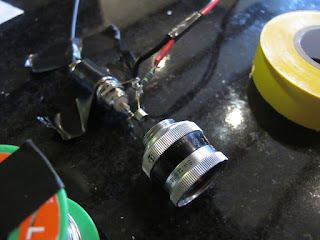Today was spent just taking measurements and looking at the results to understand what is going on with the apparatus. This is
setup 2 again with identical type 1 detectors into 50 ohms reversed biased with 25 volts.
With persistence on we can see the noisy signals from the laser.. It's not such a good laser. Channel 2 (blue) is our Df detector running at the minimum allowable vertical sensitivity my scope can muster of 2mV.
I thought It worthwhile describing how I am taking measurements on the scope. Because we have a couple of mountains rather then fantastically sharp rise times I decided to focus on at least matching the wave forms after I stop the scope running.
1) get both wave forms in view and hit STOP on the scope.
2) vertically align the peek of CH2 to the nearest grid reference.
3) scroll horiontally to the left, select CH1 and vertically align it to the base line given by CH2. Note this can be a little tricky working in the noise but after about 200 attempts you develop an eye for the average.
4) Scroll horizontally back to the wave forms and now adjust CH1 vertical fine tune to the same grid reference we decided on in step 2)
5) Iterate steps 3) and 4) until both agree. Each time you scale CH1 the vertical alignment will be out a little.
6) Get our your favorite tracking cursors and set B = 0s this is your trigger point and reference zero time measured by Df on CH2. Scroll A backwards until the two horizontal cursor lines intersect.
The theory here is that if both wave forms are vertically aligned, and both detectors are equal then the rise times should be equal and so we can derive the ToF. Here we see it as 63.2ns (a little out) but that's just one measurement.
To nullify the errors in our system we must sample lots of data and average and do statistics and stuff.
So I did some tests taking 20 measurements each time and averaging the results.
What I also did was measure my distance again and tested some other assumptions.
First the distance plays a huge role because my ability to measure it is limited, I'm using a 8 meter builders tape, dropping a plum line from my bench, marking the floor with electrical tape, running the distance to the wall, subtracting the distance from the wall to the far mirror (20mm) and all that to arrive at a new figure of 18.22m round trip after subtracting the 300mm to Df. If I had to guess - because that's about the best I can do - I would say that I got it to +-10mm. But 10mm is 4sf so is going to really influence the results.
Second is the refractive index of air that I originally put at 1.000293 based on
this Wiki page. NIST have a
couple of calculators to get more accurate values. So my 532nm laser, at 300m above sea level, at 18 degrees centigrade I keep my house at and a guess at 50% humidity gives me 1.000265104. That modification changes my error by about 0.01% so not a big deal at this stage. But for reference that puts c=299713003
Once all was done I took 140 measurements over 7 trials, each trial involved a little modification to the measurement technique and scope setup. The worst one came out at 2.42% the expected ToF, while the best trial was -0.74% (negative error meaning the time was faster then expected).
How do I account for faster than light measurements? Well all I can think of at the moment is some difference in rise times between the detectors. I'm going to do several more runs to get confident in the consistency of my measurement before I swap the detectors, that requires alignment of everything again.
All in all I'm really happy with the results thus far, despite the best error representing a 2242582m/s difference. Only 7 figures to go now :)
I found that where on the Ds waveform you obtain a trigger point has an effect. I have marked the three locations I tried below. As the wave rises from it's ground reference point we first get a knee at A rising through B at 50% and ending at the peek passing through C.
Point B is where we have the maximum dV so should be the best place to look, and that was proven true by improved accuracy when I increased my trigger voltage to about the mid point. However by the same token point B and C is where rise time errors would be most pronounced.




































